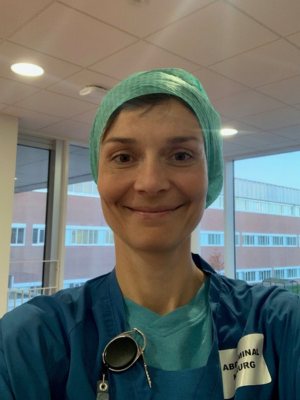National clinical study
RESPONSE: Colorectal cancer survivors’ follow-up care – now digital and need-based. A national interventional effectiveness trial for stage I and II patients
Our aim is to conduct a prospective Danish multicenter interventional effectiveness trial (RESPONSE) comparing the current standard-of-care follow-up program for stage I-II CRC survivors to a novel personalized follow-up program.
The project received funding in 2023
Principal Investigator (PI)
Postdoc

Collaborators
Aalborg University Hospital
Hjørring Regional Hospital
Randers Regional Hospital
Viborg Regional Hospital
Gødstrup Regional Hospital
Horsens Regional Hospital
Aarhus University Hospital
Odense University Hospital (Odense and Svendborg)
University of Southern Denmark
Herlev and Gentofte Hospital
Bispebjerg Hospital
Sygehus Lillebælt, Vejle Hospital
Patient enrollment
400
Cancer
Colorectal cancer
Type
Prospective interventional - non-randomized
Platform
Methylation-based ddPCR
Abstract
Background:
Colorectal cancer (CRC) screening was implemented in Denmark in 2014 and has effectively shifted the CRC stage at the time of diagnosis from late (stage III and IV) to earlier stages (stage I and II). Most patients become long term cancer survivors as their recurrence risk is low (5-10%). Nevertheless, their risk of moderate to severe treatment-related organ-specific late adverse effects is high (30-50%), and >10% have persistent low quality of life and/or high levels of psychological distress. Preferably, their follow-up program should balance the low recurrence risk against the high need for support due to late adverse effects. However, the current ‘one-size-fits-all’ follow-up program, with computed tomography (CT) imaging at 12 and 36 months, focuses solely on recurrence detection, which most stage I-II survivors (90-95%) never experience.
One approach to limit unnecessary CT imaging of these patients is to discriminate between high- and low recurrence risk patients. Circulating tumor DNA (ctDNA) is a promising biomarker with such discriminative abilities: if serially collected blood samples are screened for the presence of ctDNA, recurrence can be detected with high sensitivity (88%) and specificity (97%), independently of CRC stage. Followingly, serial ctDNA analyses have the potential to pin-point the 5-10% of high recurrence risk patients, that should be offered CT imaging.
Up to 50% of CRC survivors suffer from reduced quality of life (QoL) related to fear of recurrence; treatment related psychological late effects; and/or severe organ-specific late adverse effects. These ‘late adverse effects’ can effectively be identified by electronic patient-reported outcome measures (ePROMs). Recently, a growing body of evidence suggests that ‘late adverse effects’ can be treated effectively with cognitive-behavioral approaches and organ-specific intervention in specialized ‘late adverse effects’ centers. Thus, ePROMs have the potential to help clinicians identify CRC survivors with severe ‘late adverse effects’ and offer them treatment that could potentially improve their QoL.
Aim:
Our aim is to conduct a prospective Danish multicenter interventional effectiveness trial (RESPONSE) comparing the current standard-of-care follow-up program for stage I-II CRC survivors to a novel personalized follow-up program: The novel program risk stratifies CRC survivors by serial ctDNA analyses with a tumor-agnostic test (TriMeth), and only high recurrence risk patients are offered CT imaging, reducing follow-up cost. The saved resources are redirected to identification and management of treatment related sequelae, to improve QoL in patients with debilitating ‘late adverse effects’.
Materials and methods:
RESPONSE will enrol ~400 stage I-II CRC patients 1:1 to an intervention group (IG) or standard follow-up group (SG) within the existing IMPROVE network of 11 colorectal cancer surgical centers in four of five Danish regions. IG will receive 1) ctDNA-guided recurrence detection with a tumor-agnostic detection method; 2) personalized self-managed follow-up care using a digital care guide; 3) systematic monitoring of ‘late adverse effects’ with ePROMs; and 4) intervention for clinically significant ‘late adverse effects’. The digital care guide will be offered as a smartphone app to help maintain patient autonomy. It will serve as both a collection of information and a timed tool to inform, educate, guide, and remind the patient about the follow-up program and ePROMs, and includes directions on how to manage late sequelae and symptoms of recurrence. SG will receive standard-of-care follow-up: post-surgery CT imaging at 12 and 36 months.
Recruitment happens post-surgery and the region of residency determines the allocation to either IG or SG. Patients residing in Central Denmark Region and North Denmark Region will be recruited to the IG. Patients residing in the remaining Danish Regions will be recruited to the SG and receive standard-of-care follow-up. The motivation for this patient allocation is that only the North and Central Denmark Regions have fully implemented, standardized late effects clinics offering a patient-centered, interdisciplinary, multiorgan approach. Furthermore, they are currently implementing the same smartphone-based digital care guide.
Primary outcomes will be the between-group difference in QoL 3-years post-surgery, evaluated by EORTC OLQ-C30. Secondary outcomes include differences in fear-of-cancer-recurrence-index, severity of ‘late adverse effects’, recurrence-free survival (RFS), and health care costs.
Conclusion:
We hypothesize that the new follow-up program will improve the 3-year post-surgery QoL without compromising RFS or increasing costs. The proposed study design is transferable to other cancer survivors and may become a future framework for improving post-operative follow-up.
ADDRESS FOR THE SECRETARIAT
Science Center Skejby, MOMA
Brendstrupgårdsvej 21, build. A
8200 Aarhus N
CONTACT
ctDNA@clin.au.dk
+45 78 45 53 39

